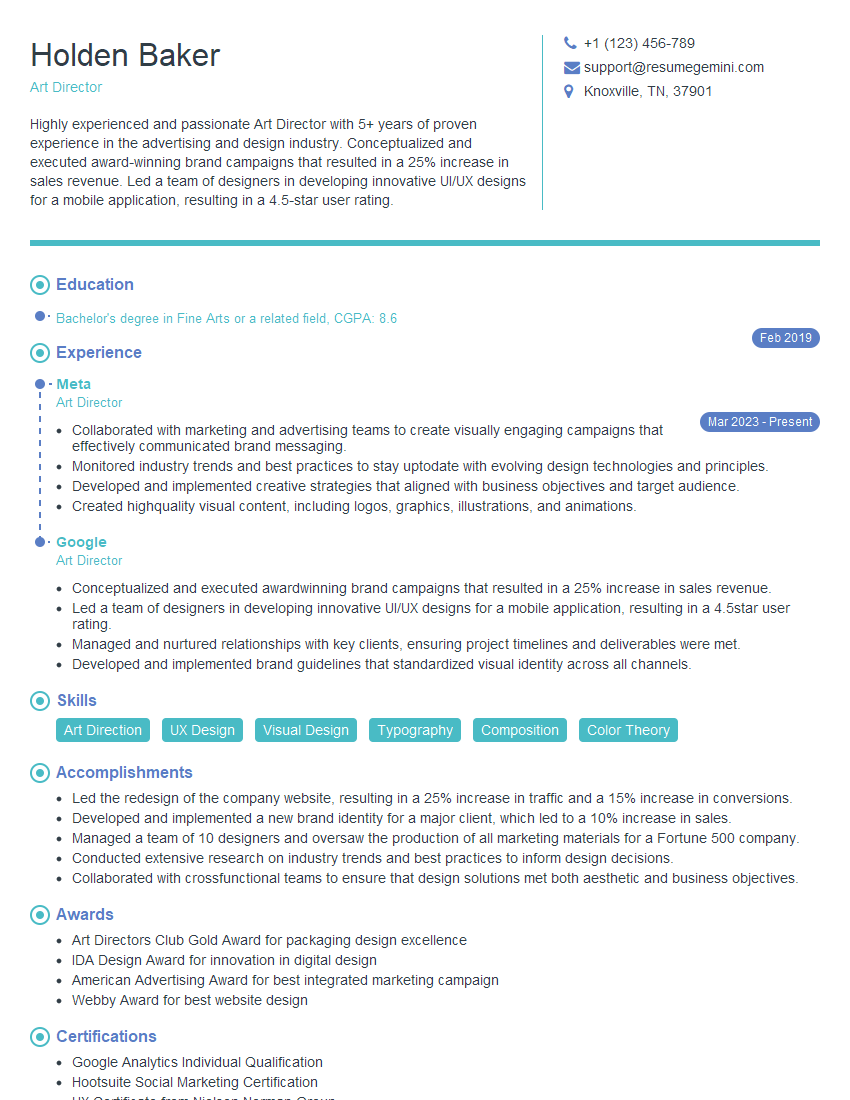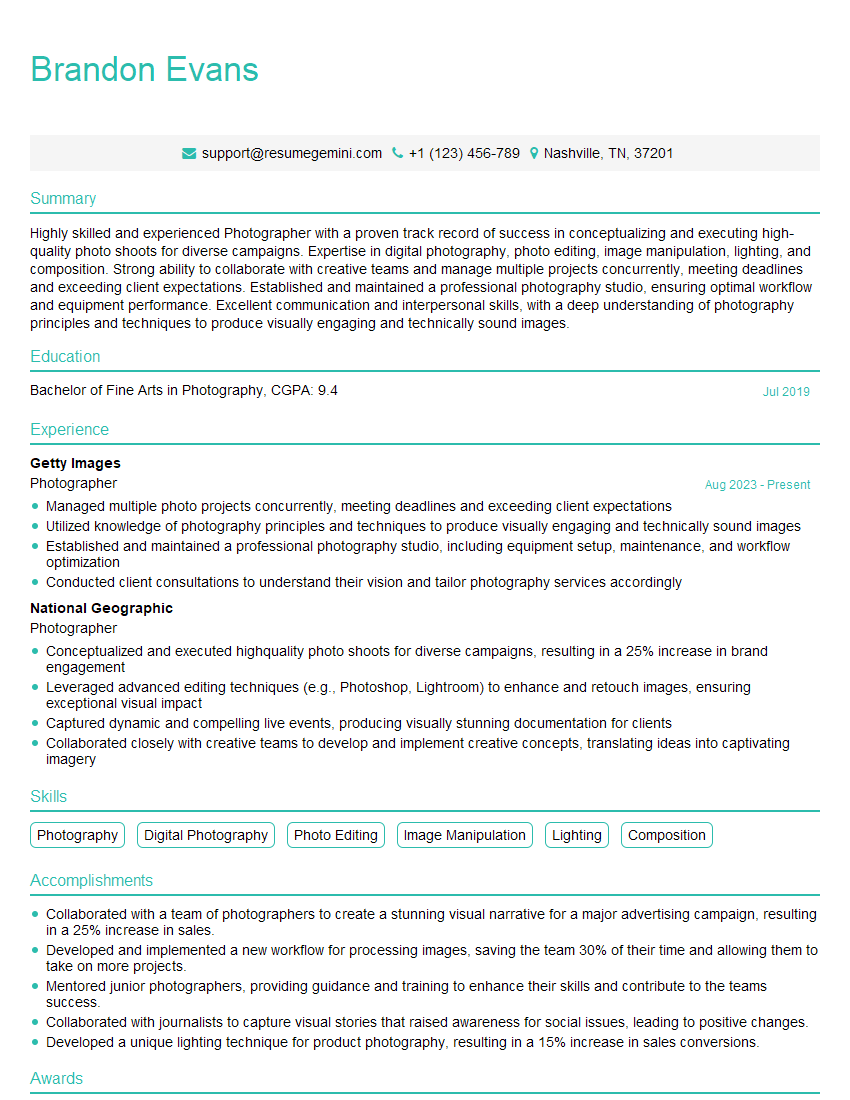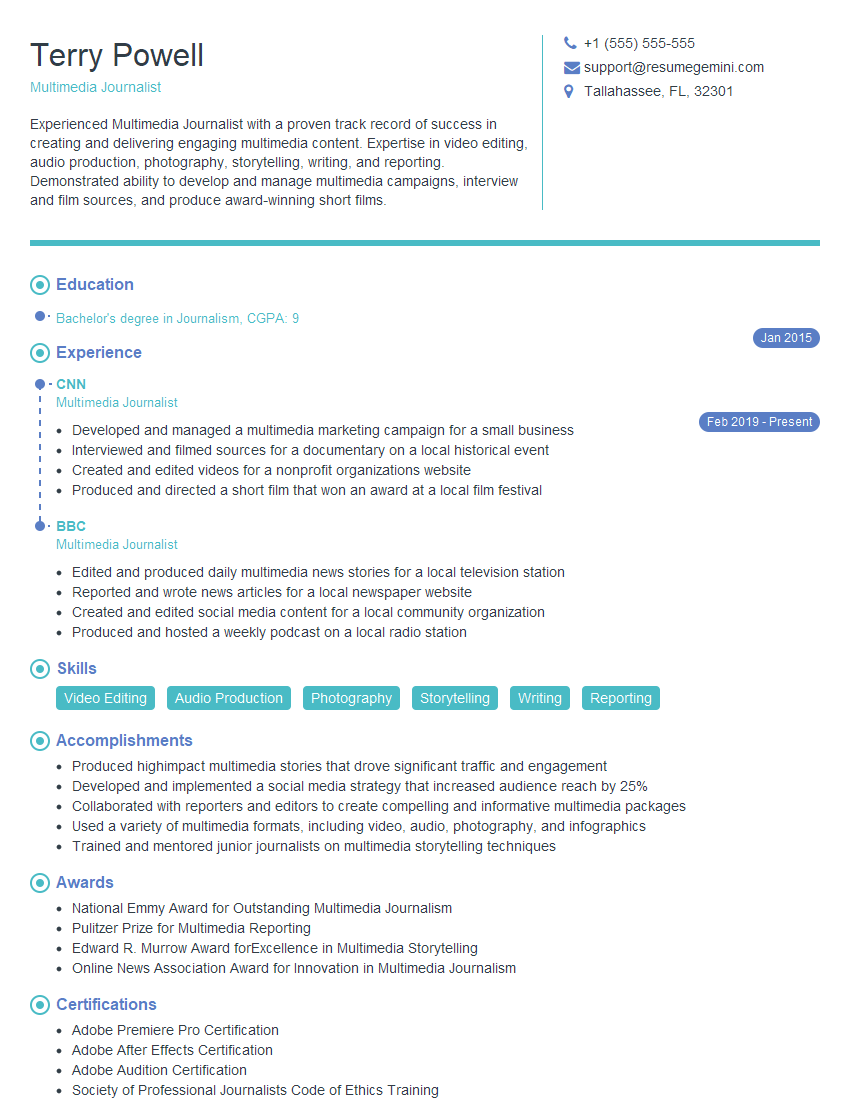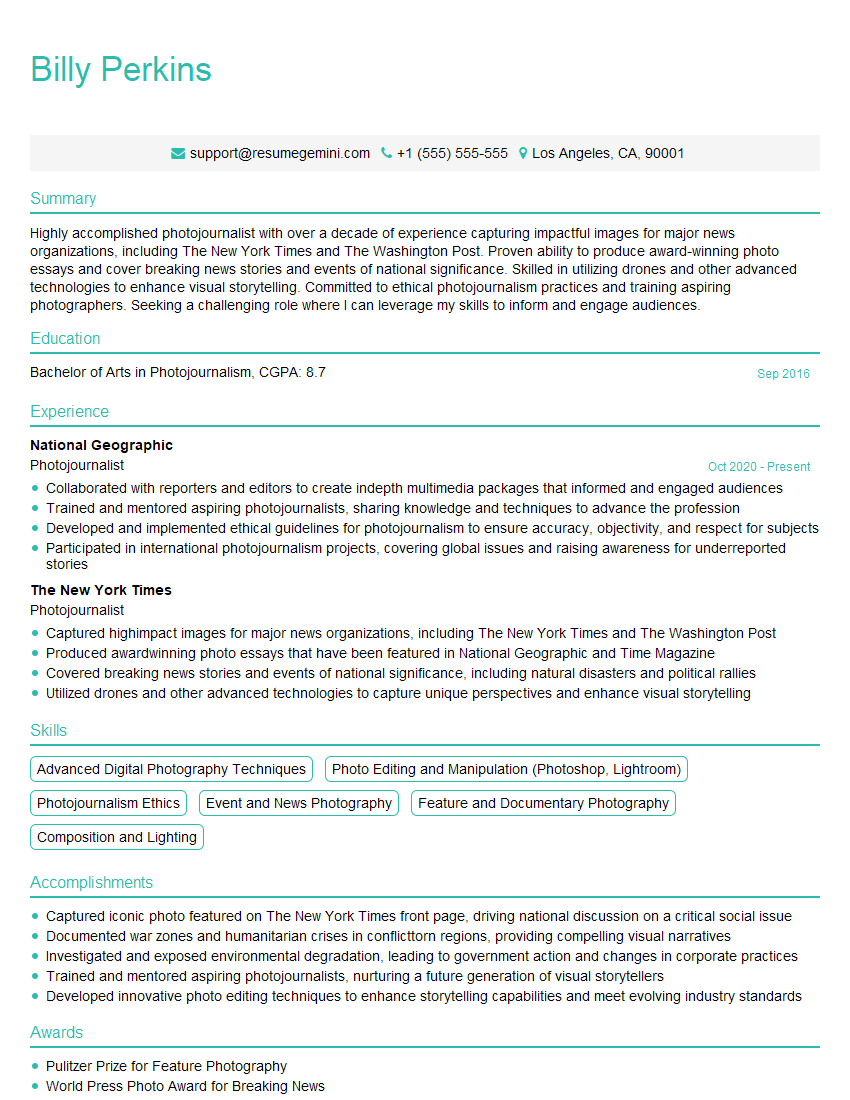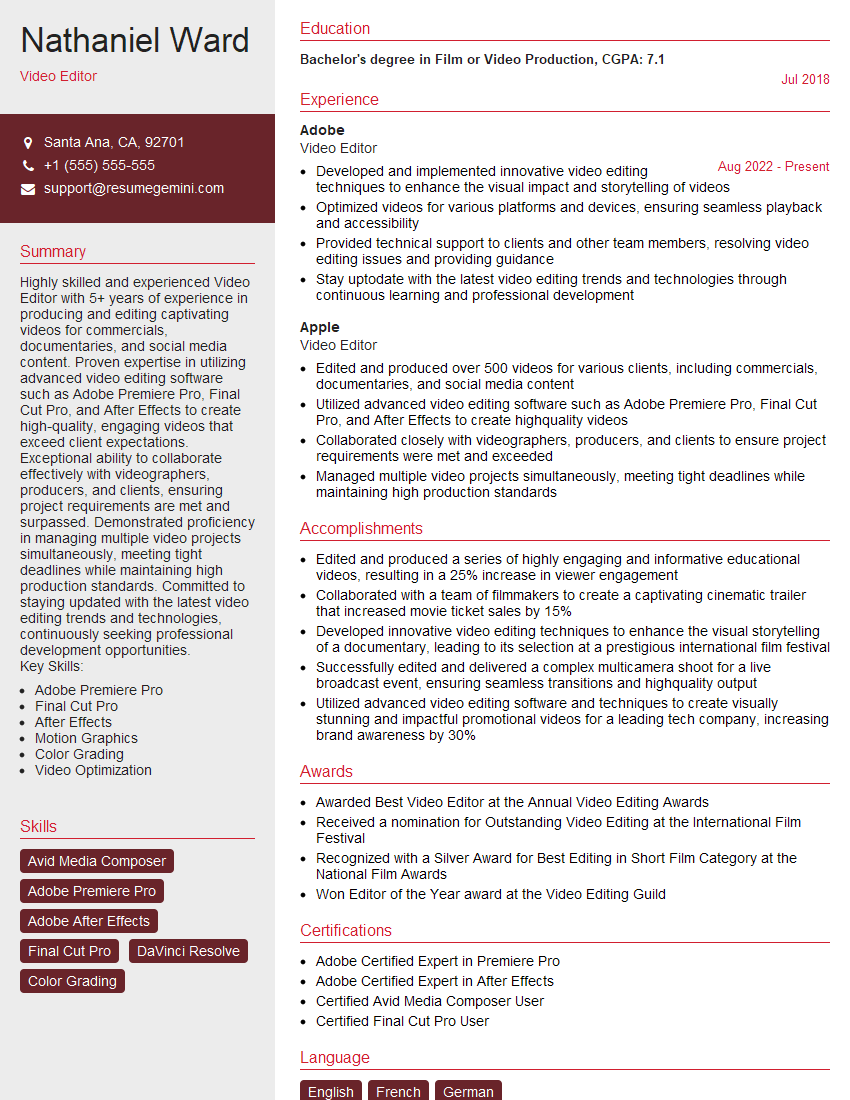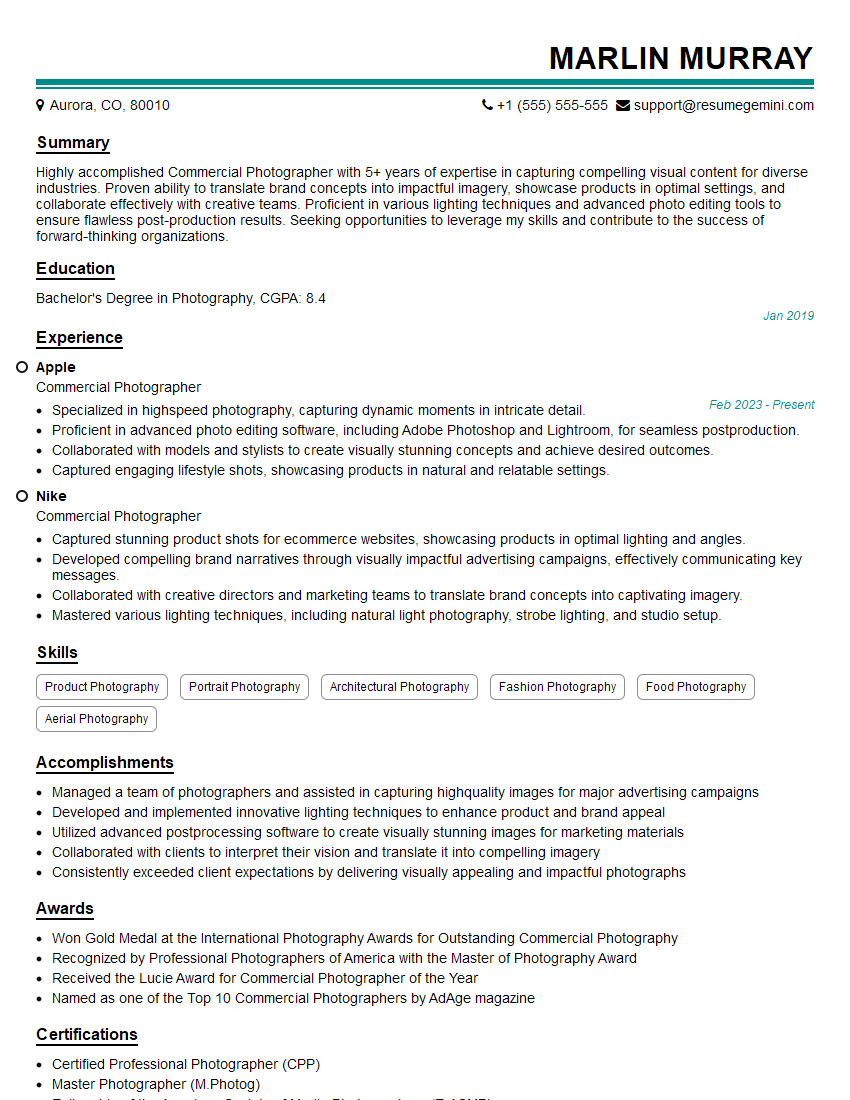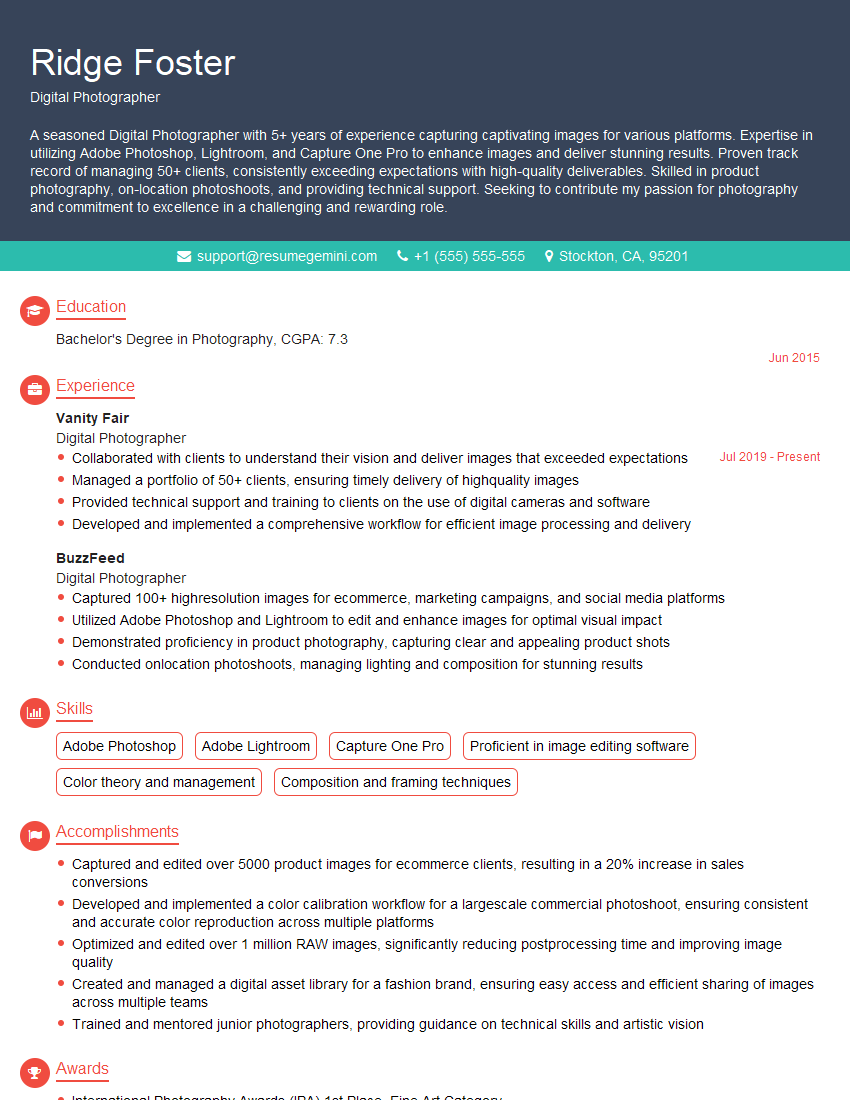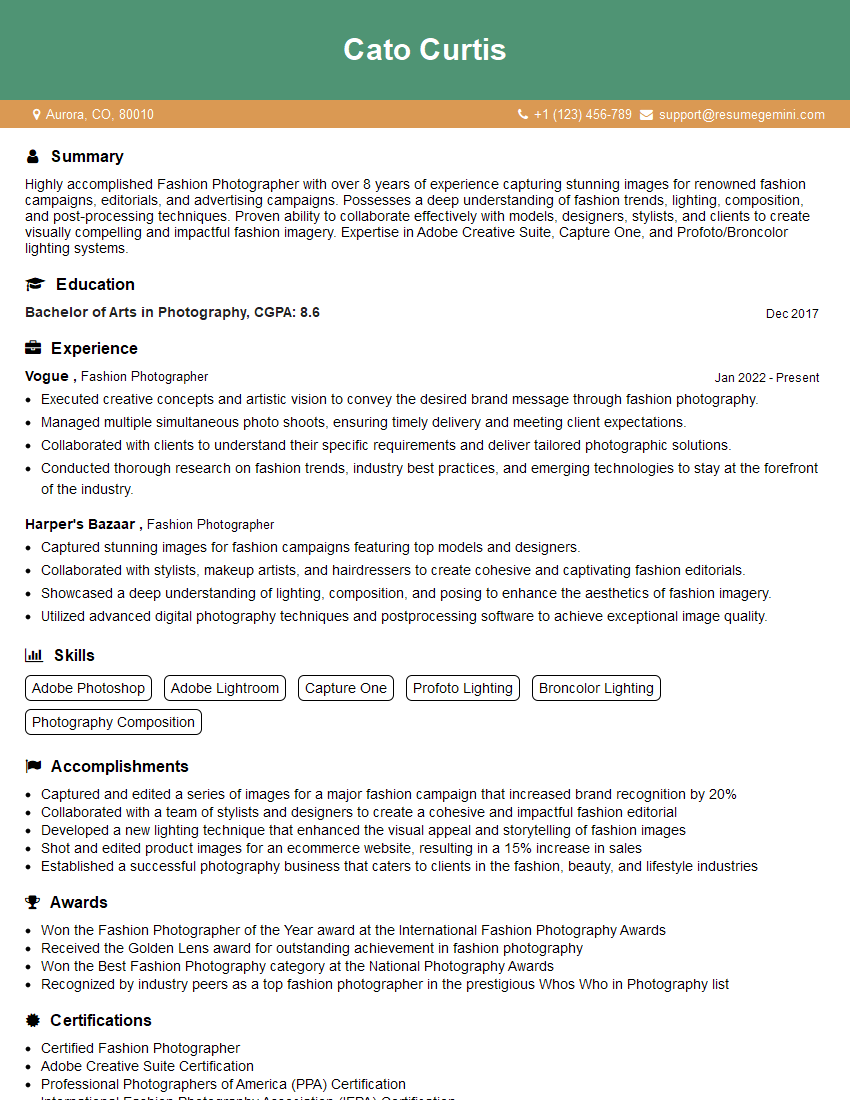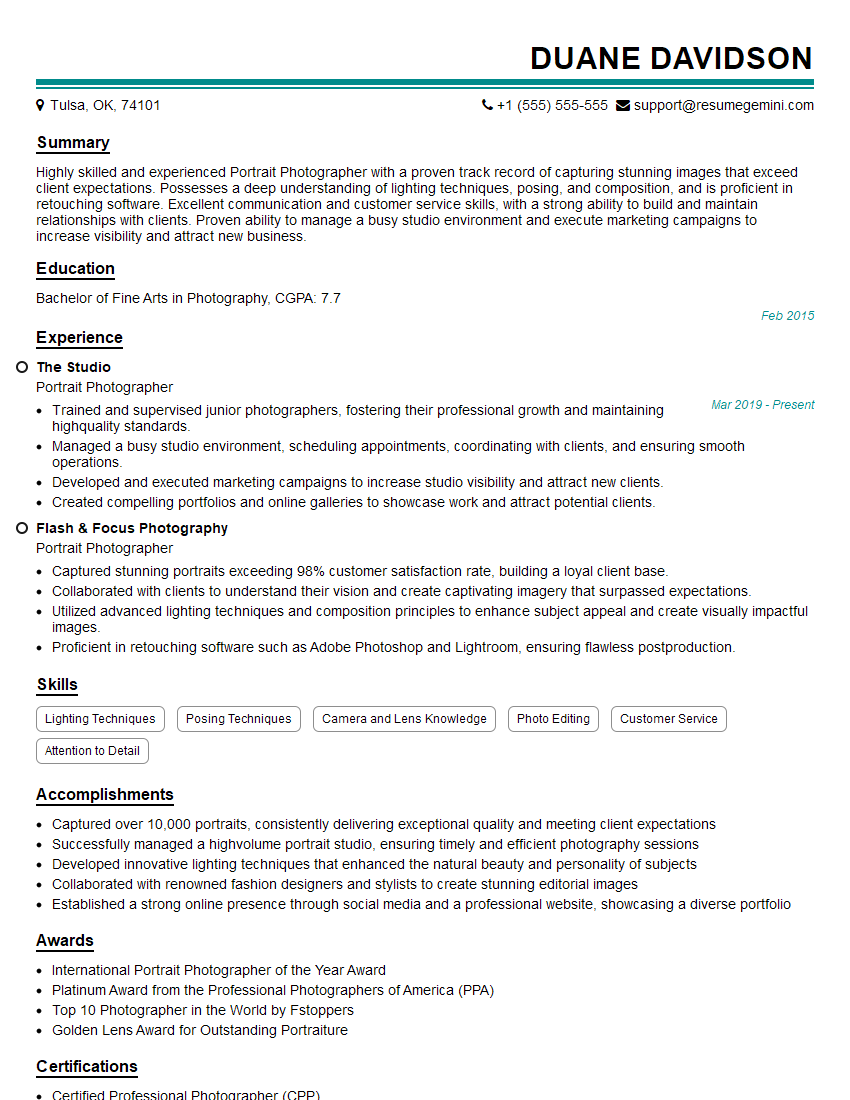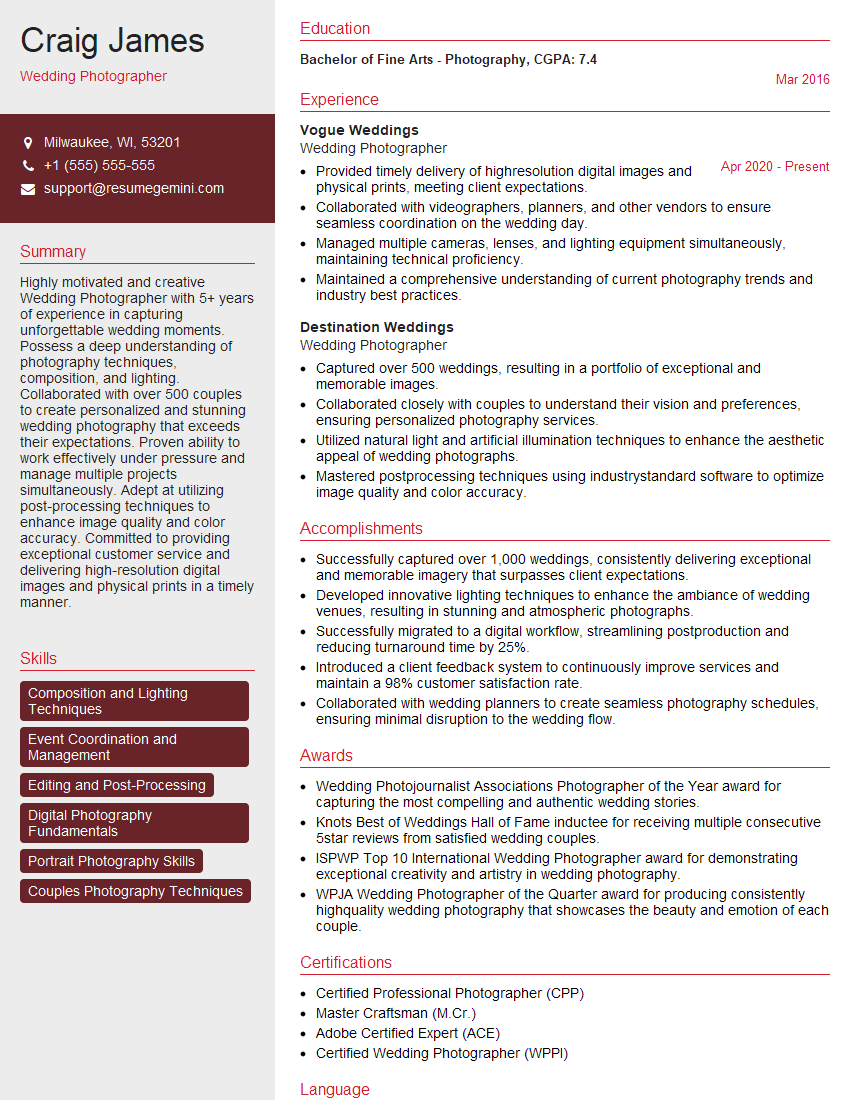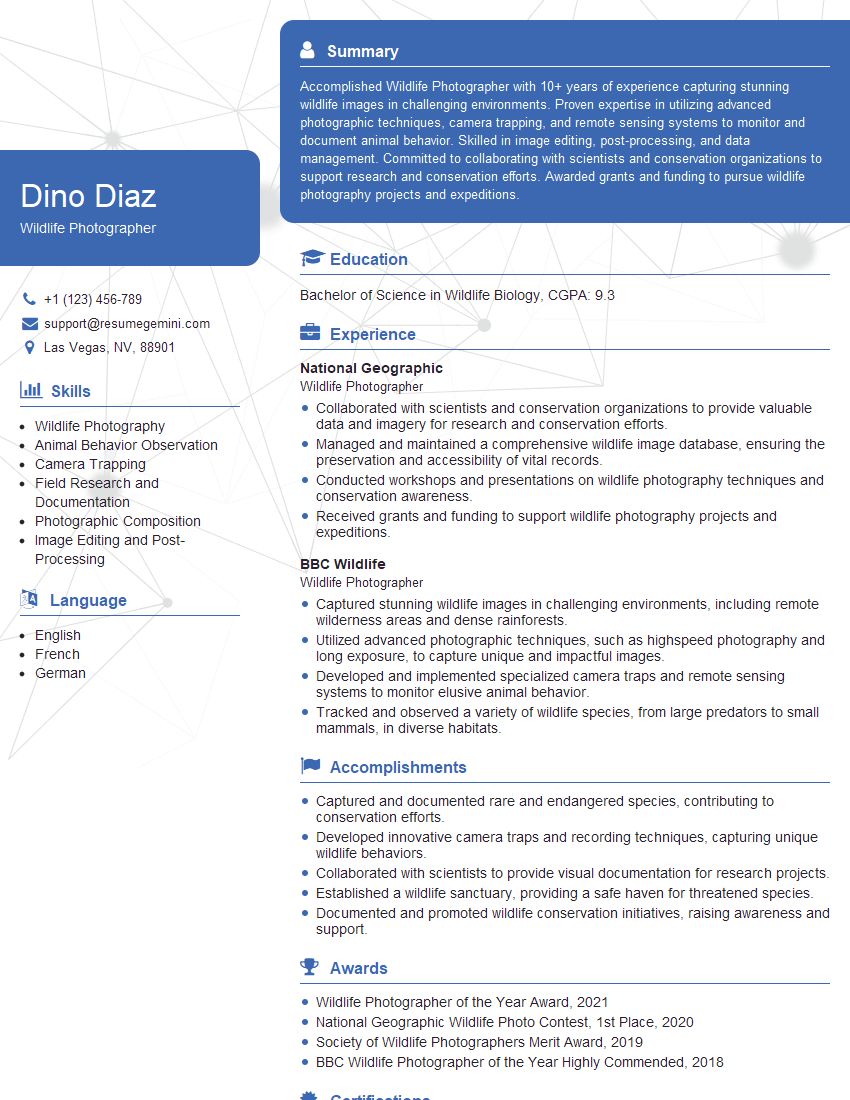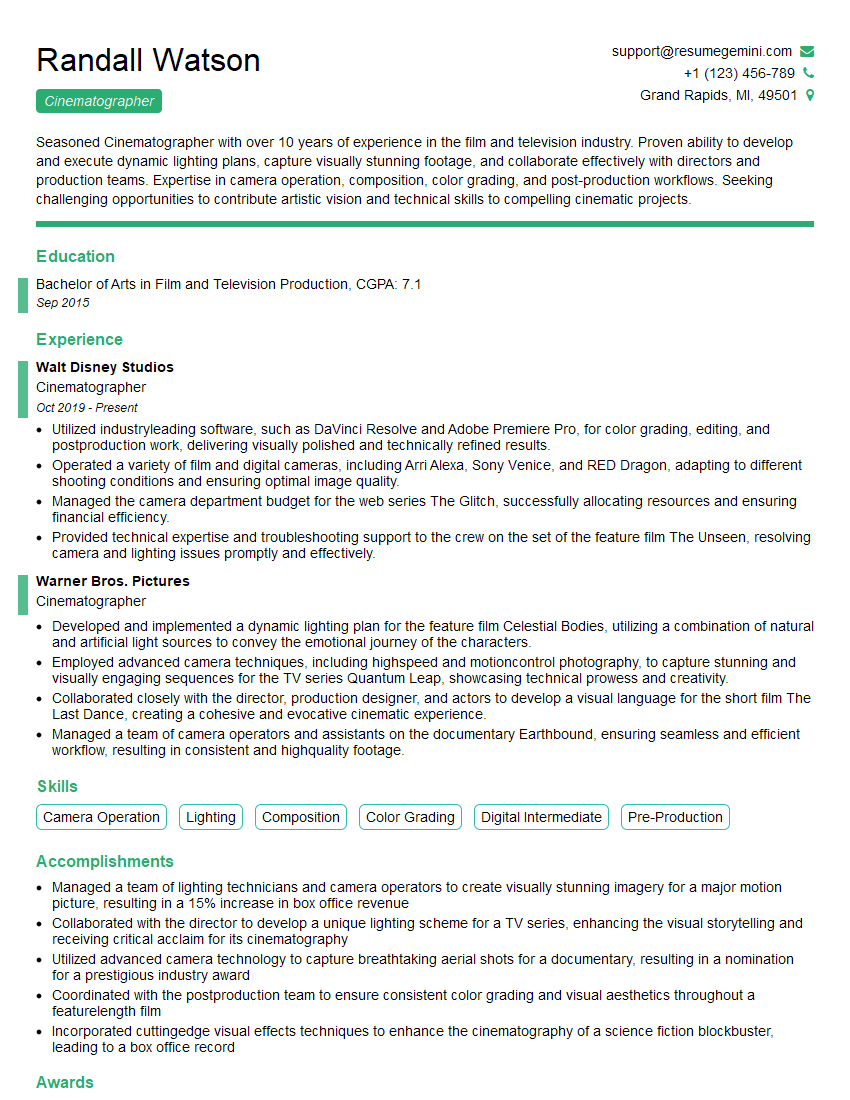Preparation is the key to success in any interview. In this post, we’ll explore crucial Passion for Photography and Visual Storytelling interview questions and equip you with strategies to craft impactful answers. Whether you’re a beginner or a pro, these tips will elevate your preparation.
Questions Asked in Passion for Photography and Visual Storytelling Interview
Q 1. Explain your photographic style and how it aligns with visual storytelling.
My photographic style leans towards a naturalistic and evocative approach, prioritizing authentic moments and emotional depth. I aim to capture the essence of a scene or subject rather than just a technically perfect image. This aligns perfectly with visual storytelling because it’s about conveying a feeling or narrative through imagery, not just showcasing technical skill. For example, instead of perfectly posed portraits, I often prefer candid shots that reveal genuine emotion. A photograph of a laughing child playing in the park tells a more compelling story than a staged, overly posed portrait. This approach ensures the viewer connects with the subject and the narrative on a more human level.
I believe a strong photograph should resonate with the viewer long after they’ve seen it, prompting reflection and potentially eliciting an emotional response. This isn’t just about capturing a pretty picture; it’s about telling a story that lingers in the viewer’s memory. My approach involves careful consideration of composition, light, and subject matter to create images that resonate with this principle.
Q 2. Describe your experience with different photography equipment and techniques.
My experience spans various photographic equipment and techniques. I’m proficient with both DSLR and mirrorless cameras, understanding the strengths and limitations of each system. I’ve worked extensively with various lens types, from wide-angle lenses for landscape photography to telephoto lenses for wildlife or sports photography. My experience also extends to lighting equipment, including strobes, speedlights, and continuous lighting, allowing me to control and shape light to achieve the desired effect.
Techniques I employ include various shooting modes (aperture priority, shutter priority, manual), mastering different focal lengths and apertures to control depth of field, and understanding the role of ISO in managing image noise. I’m also adept at various photography techniques like long exposures for capturing light trails or movement, panning to create motion blur, and using different filters to enhance my images. My knowledge extends to both film and digital photography, offering a deeper understanding of the photographic process.
Q 3. How do you approach a project requiring both photography and video elements?
Approaching a project requiring both photography and video necessitates a holistic strategy focusing on consistent narrative flow and visual language. The planning stage is critical. I begin by creating a comprehensive storyboard, outlining shots for both photography and video, ensuring a cohesive narrative. This allows for efficient shooting and post-production workflows. For example, I might plan a sequence where a still photograph establishes a setting, followed by a video showcasing movement or interaction within that setting.
During the shoot, I carefully consider the lighting and composition for both media types. While photographic composition focuses on single frames, video requires considering continuity and pacing. Post-production involves editing both the photos and videos, ensuring a unified aesthetic and smooth transitions between still and moving images. This might involve color grading and stylistic choices that remain consistent across all media to create a cohesive final product. Ultimately, the goal is to leverage the strengths of each medium – the impactful stillness of photography and the dynamic flow of video – to create a truly immersive and compelling story.
Q 4. Discuss your experience with post-processing and image editing software.
I’m highly proficient in Adobe Photoshop and Lightroom, the industry-standard software for post-processing and image editing. I utilize them for everything from basic adjustments like exposure, contrast, and white balance, to more advanced techniques such as retouching, color grading, and compositing. Lightroom is my primary tool for organizing, cataloging and performing initial edits. Photoshop then handles more complex tasks needing finer pixel-level control.
My workflow typically involves importing images into Lightroom, performing initial adjustments, and selecting images for further refinement in Photoshop. In Photoshop, I utilize layers, masks, and various adjustment layers to achieve precise and non-destructive edits. I understand the importance of maintaining image integrity while enhancing its visual appeal, avoiding over-processing and staying true to the original capture. I’m always seeking new ways to improve my proficiency, keeping up with industry trends and software updates.
Q 5. How do you manage time constraints during photo shoots or projects?
Managing time constraints during photoshoots requires meticulous planning and efficient execution. Before any shoot, I create a detailed shot list, prioritizing essential shots and allocating sufficient time for each. This involves considering factors like lighting conditions, subject availability, and potential logistical challenges. It’s crucial to communicate clearly with the client and the team, ensuring everyone understands the schedule and their roles.
During the shoot, I maintain a flexible yet focused approach. I prioritize capturing the key shots first, leaving room for improvisation and unexpected opportunities. Efficient communication, quick camera setup, and a well-organized workflow help save valuable time. I also utilize assistants where appropriate to streamline the process and focus my attention on creative decisions. The key is to stay adaptable, prioritize, and remain calm under pressure.
Q 6. Describe your process for selecting and editing images for a story.
Selecting and editing images for a story is a crucial step in the storytelling process. My approach begins with a careful review of all captured images, looking beyond technical perfection and focusing on emotional impact and narrative flow. I look for images that convey the essence of the story, capture key moments, and create a visual rhythm.
The editing process is iterative. I start by eliminating unsuitable images (out of focus, poorly composed, etc.). Then I refine the remaining images using software like Lightroom and Photoshop. I consider the overall narrative arc when sequencing images, ensuring a smooth and compelling visual progression. The final selection aims for a balance between emotional impact, visual diversity, and narrative coherence. The selected images should tell a cohesive story, building on each other to create a lasting impression on the viewer.
Q 7. How do you ensure the visual aspects of your work align with the narrative?
Ensuring visual alignment with the narrative is paramount. It’s about creating images that not only look good but also effectively communicate the story’s theme, tone, and message. This starts with a deep understanding of the story’s narrative elements – its plot, characters, setting, and themes.
I employ several strategies to achieve this alignment. I choose locations, lighting, and compositions that resonate with the story’s emotional tone. For example, a dark and moody atmosphere might suit a story about loss, whereas bright and vibrant colors might be appropriate for a story about joy. Careful consideration of color palettes, framing, and subject matter ensures the visual elements reinforce the narrative’s key aspects. Ultimately, the visual language of my photography works in tandem with the narrative, enhancing the viewer’s understanding and emotional connection to the story.
Q 8. Explain your understanding of composition, lighting, and other photographic principles.
Photography, at its core, is about visual communication. Mastering composition, lighting, and other photographic principles is crucial for effective storytelling. Composition refers to the arrangement of elements within the frame to create a visually appealing and meaningful image. Think of it as the visual grammar of your photograph. Key elements include:
- Rule of Thirds: Dividing the frame into nine equal parts and placing key elements along these lines or at their intersections creates a more dynamic and engaging image than centering the subject.
- Leading Lines: Using lines within the image to guide the viewer’s eye towards the main subject. Roads, rivers, or fences can act as powerful leading lines.
- Symmetry and Patterns: Creating balance and visual interest through symmetrical compositions or repeating patterns.
- Framing: Using elements within the scene, like arches or foliage, to frame the main subject and draw attention to it.
Lighting is equally crucial. It shapes the mood, highlights textures, and guides the viewer’s focus. Different lighting techniques evoke different emotions:
- Natural Light: Golden hour (sunrise and sunset) offers warm, soft light, ideal for portraits and landscapes. Harsh midday sun can create strong shadows, useful for dramatic effect.
- Artificial Light: Using strobes, continuous lighting, or even lamps allows for precise control over light direction, intensity, and color temperature, crucial for studio work or low-light situations.
Beyond these, other photographic principles include depth of field (controlling the area in focus), aperture (controlling the amount of light entering the lens), shutter speed (controlling motion blur), and ISO (controlling sensitivity to light).
Understanding and effectively utilizing these elements allows photographers to create powerful and evocative images that effectively tell a story.
Q 9. Describe a project where you had to overcome a significant technical challenge.
During a project documenting the annual migration of Monarch butterflies, I faced a significant technical challenge: capturing their delicate wings in sharp detail while also showcasing their movement. The butterflies were incredibly fast, and using a high shutter speed to freeze their motion resulted in underexposed images due to the low light conditions during the early morning shoots.
To overcome this, I employed a multi-pronged approach:
- Pre-visualization and scouting: I carefully planned my shots by scouting locations beforehand to anticipate butterfly flight patterns and optimal lighting conditions.
- Equipment optimization: I used a fast lens (f/2.8 or faster) to maximize the amount of light reaching the sensor. I also increased my ISO setting, accepting some noise in exchange for faster shutter speeds.
- Continuous shooting mode: I used my camera’s continuous shooting mode to capture a burst of images, increasing the odds of getting a sharp shot. This resulted in numerous images to choose from.
- Post-processing: In post-processing, I utilized techniques like noise reduction to minimize the impact of the higher ISO, ensuring the final images retained their quality without excessive grain.
The combination of careful planning, optimized equipment settings, and post-processing techniques allowed me to capture stunning images that conveyed both the beauty and movement of the Monarch butterflies.
Q 10. How do you incorporate audience consideration into your visual storytelling?
Audience consideration is paramount in visual storytelling. Before even picking up a camera, I ask myself: Who is my target audience? What is their level of understanding of the subject matter? What emotions do I want to evoke in them?
For instance, when creating a photo essay about climate change for a general audience, I would use visually impactful images that are easy to understand and emotionally engaging. I’d avoid highly technical jargon and focus on showing the human impact of climate change. Conversely, if the audience were climate scientists, I could incorporate more technical details and utilize data visualizations to convey a more nuanced and scientific message.
Understanding the audience’s background, their level of knowledge, and their emotional responses is crucial for crafting a story that resonates and achieves its intended purpose.
Q 11. What are your preferred methods for researching and planning a visual project?
My research and planning process is iterative and involves several key steps:
- Defining the story: Clearly articulating the narrative I want to tell. What is the central message? What emotions do I want to evoke?
- Audience research: Understanding the target audience’s knowledge, interests, and expectations.
- Location scouting: Identifying potential locations that align with the story and offer aesthetically pleasing visuals. This often involves creating mood boards and shot lists.
- Visual research: Studying existing visual work on similar topics to identify successful storytelling techniques and avoid clichés.
- Storyboard creation: Visualizing the sequence of shots, including composition, lighting, and emotional tone. This helps in planning efficient shooting sessions.
- Equipment planning: Choosing the right cameras, lenses, and lighting equipment based on the project’s needs.
This structured approach ensures a focused and efficient workflow, allowing me to achieve my creative vision effectively.
Q 12. How do you handle feedback on your work, both positive and constructive?
Feedback is an invaluable tool for growth. I approach both positive and constructive criticism with an open mind, valuing each perspective as an opportunity to learn and improve. Positive feedback reinforces my strengths and validates my creative decisions. I use constructive criticism as a roadmap for refinement, considering suggestions objectively and assessing their relevance to my goals.
My approach is to carefully analyze feedback, separating subjective opinions from factual observations. I may not always incorporate every suggestion, but I engage with each piece of feedback thoughtfully, reflecting on how it can help me improve future projects.
Q 13. What software or tools are you proficient in for visual storytelling?
My workflow relies heavily on a variety of software and tools. For image editing and post-processing, I am proficient in Adobe Lightroom and Photoshop. Lightroom helps with organizing, editing, and color grading, while Photoshop provides more advanced tools for retouching and compositing. For video editing, I use Adobe Premiere Pro, which is efficient for assembling footage, adding effects, and creating polished videos.
Beyond these, I use Capture One for tethered shooting and advanced image adjustments. I also utilize various cloud storage solutions for backup and collaboration.
Q 14. How do you stay updated with the latest trends in photography and visual storytelling?
Staying updated in the dynamic field of photography and visual storytelling requires a multifaceted approach:
- Following industry publications and blogs: I regularly read online and print publications dedicated to photography, visual storytelling, and digital art.
- Attending workshops and conferences: Participating in industry events allows for networking and learning from experts and peers.
- Engaging with online communities: Active participation in photography forums and social media groups provides valuable insights and allows me to learn from others’ experiences.
- Experimenting with new techniques and software: I continually try new software, techniques, and approaches to expand my skillset and discover new creative avenues.
This combination of active learning and hands-on experimentation helps ensure my skills remain sharp and my creative vision stays fresh.
Q 15. Describe your experience collaborating with other creatives (designers, writers, etc.).
Collaboration is the lifeblood of impactful visual storytelling. I’ve worked extensively with designers, writers, and marketing professionals, finding that a shared vision is key. For instance, on a recent project for a sustainable fashion brand, I collaborated closely with the brand’s creative director and copywriter. The director provided mood boards and design concepts, while the writer shared the brand’s narrative and key messaging. My role was to translate those elements into compelling visuals that strengthened the overall story. We held regular brainstorming sessions, reviewed drafts together, and provided constructive feedback throughout the process. This iterative approach allowed us to create a cohesive and powerful campaign that exceeded expectations. Effective communication and mutual respect for each other’s expertise were crucial to the project’s success. I believe in a collaborative workflow that values diverse perspectives and leverages the unique skills of each team member.
- Example 1: Working with a graphic designer to ensure my photographs seamlessly integrate into a website’s overall layout and branding.
- Example 2: Partnering with a writer to craft captivating captions that complement the emotional impact of my photographs in a travel blog.
Career Expert Tips:
- Ace those interviews! Prepare effectively by reviewing the Top 50 Most Common Interview Questions on ResumeGemini.
- Navigate your job search with confidence! Explore a wide range of Career Tips on ResumeGemini. Learn about common challenges and recommendations to overcome them.
- Craft the perfect resume! Master the Art of Resume Writing with ResumeGemini’s guide. Showcase your unique qualifications and achievements effectively.
- Don’t miss out on holiday savings! Build your dream resume with ResumeGemini’s ATS optimized templates.
Q 16. How do you create a visual narrative that resonates with the target audience?
Creating a resonant visual narrative begins with deep understanding of the target audience. Who are they? What are their values, aspirations, and pain points? What kind of visual language speaks to them? I use a combination of research, empathy, and creative intuition to answer these questions. For example, a campaign for a youth-oriented brand would require a different visual style than a campaign for a luxury car manufacturer. The youth campaign might use vibrant colors, dynamic compositions, and authentic, unpolished imagery, while the luxury campaign would likely prioritize elegance, sophistication, and high-quality production values. It’s about choosing the right visual elements – color palettes, lighting, composition, subject matter – to evoke the desired emotions and connect with the audience on an emotional level. Think of it like storytelling with a camera: You’re choosing each shot to build a compelling scene, each character to convey a message, and the setting to strengthen the narrative’s essence.
Q 17. How do you balance artistic vision with client expectations in commercial projects?
Balancing artistic vision with client expectations is a delicate dance, but a crucial one. It’s about finding common ground where creativity and business objectives intersect. Open communication is paramount. I start by actively listening to the client’s needs, understanding their brief, and asking clarifying questions. I then present my creative vision, explaining my artistic choices and how they align with the project goals. This often involves showcasing mood boards, style guides, and examples of my previous work that demonstrates a similar aesthetic or approach. Sometimes, compromises are necessary. This might involve adjusting the color palette, composition, or even the subject matter slightly. But I strive to maintain the integrity of my artistic vision while meeting the client’s requirements, ensuring we both feel satisfied with the end result. The key is to build trust and foster a collaborative relationship where we work together to achieve a mutually beneficial outcome.
Q 18. Explain your understanding of copyright and image usage rights.
Copyright and image usage rights are fundamental aspects of my profession. I understand that copyright protection automatically applies to my original photographs the moment I create them. This means I own the exclusive rights to reproduce, distribute, display, and create derivative works from my images. When I work with clients, I clearly define the scope of their usage rights in a contract. This outlines which specific images they can use, where they can use them (e.g., website, print advertising), for how long, and whether they have the right to modify or adapt the images. I also always obtain model releases for photographs involving identifiable individuals, and property releases when necessary. I ensure clients understand the implications of using my images without proper licensing, and I actively protect my intellectual property. Ignorance of copyright laws is not a valid excuse for infringement. It’s my responsibility to educate clients and ensure legal compliance in every project.
Q 19. Describe your experience with different types of photography (e.g., portrait, landscape, etc.).
My photography experience spans diverse genres, including portraiture, landscape, lifestyle, and product photography. Portrait photography, for me, is about capturing the essence of a person – their personality, their emotions, their story. I strive to create images that are both aesthetically pleasing and emotionally engaging. Landscape photography offers a different kind of challenge: to capture the grandeur and beauty of nature, to convey a sense of awe and wonder. I enjoy experimenting with different compositions, lighting conditions, and perspectives to create unique and compelling landscapes. Lifestyle photography allows me to showcase products or brands in realistic, everyday settings, which helps build a strong connection with potential customers. Product photography requires precision and attention to detail, ensuring that the product is displayed in a way that highlights its features and benefits. Each genre presents unique challenges and rewards, constantly enriching my creative capabilities.
Q 20. How do you adapt your style and techniques to various projects and environments?
Adaptability is essential in photography. My style and techniques evolve depending on the project’s nature, the environment, and the client’s vision. For example, a vibrant, street-style approach might be perfect for a youth-oriented fashion campaign, while a more subtle, minimalist style might be suitable for a luxury brand. The environment also plays a crucial role. Shooting in a studio allows for greater control over lighting and composition, while shooting outdoors demands adaptability to changing weather conditions and available light. I always invest time in researching the project beforehand – studying location specifics, understanding the client’s brand guidelines, and researching relevant visual references – to ensure I can seamlessly adapt my approach and deliver exceptional results in any situation. This includes preparing different equipment for varied settings; studio lighting for indoor work differs greatly from the natural light approach needed for outdoor shots.
Q 21. Describe your workflow from concept to final delivery in a visual storytelling project.
My workflow in a visual storytelling project is a structured, iterative process. It begins with a thorough understanding of the project brief, the target audience, and the desired narrative. I then develop a detailed concept, outlining the key visuals, the overall aesthetic, and the story I want to tell. This often involves creating mood boards and storyboards to visualize the final product. Next comes the shooting phase, where I meticulously plan each shot, considering composition, lighting, and other technical aspects. Post-production is crucial. This includes editing, color grading, and retouching to ensure the images align with the overall vision and enhance the story’s impact. Finally, I deliver the final images in the agreed-upon format, along with any necessary metadata or documentation. Throughout the entire process, communication with the client is vital – regular updates, feedback sessions, and revisions ensure that the final product meets and exceeds their expectations. The entire workflow is a constant feedback loop, ensuring the story is compelling and accurately conveyed.
Q 22. How do you ensure consistency of visual style across a series of images or videos?
Maintaining a consistent visual style across a series of images or videos is crucial for building a cohesive narrative and brand identity. This involves careful planning and execution across several key areas.
- Pre-Production Planning: Defining a style guide is paramount. This document should outline aspects such as color palettes (e.g., muted tones for a nostalgic feel, vibrant colors for energy), composition rules (e.g., consistent use of the rule of thirds, leading lines), lighting styles (e.g., natural light, dramatic shadows), and even specific editing techniques (e.g., film grain, specific filters).
- Equipment and Settings: Consistency in camera settings (aperture, ISO, shutter speed) is vital, particularly when shooting multiple takes over time. Using the same camera and lenses throughout the project will also minimize variations in image quality. For video, maintaining consistent frame rates and resolutions is essential.
- Post-Production Workflow: Employing a standardized editing process helps achieve visual unity. This includes establishing a consistent color grading scheme, applying similar effects sparingly and consistently, and carefully choosing fonts and text styles if incorporating typography.
For instance, in a documentary series about a specific region, maintaining consistent color grading, light and shadow patterns, and camera angles throughout ensures the viewers experience a seamless visual journey, rather than a disjointed collection of shots.
Q 23. Explain your experience using storytelling techniques to convey complex information visually.
Visual storytelling is about conveying complex information in an engaging and easily digestible way. My approach involves several key techniques:
- Narrative Arc: I structure the visuals to follow a clear narrative arc – beginning, middle, and end – just like a compelling story. This builds anticipation and makes the information more memorable.
- Visual Metaphors and Symbolism: Abstract concepts can be made tangible through visual metaphors. For example, to illustrate ‘economic instability’, I might use images of a crumbling building or a rollercoaster ride. Symbolism adds depth and layers of meaning.
- Data Visualization: Infographics, charts, and graphs can be visually captivating and communicate data effectively when combined with compelling visuals and minimal text. I always prioritize clarity and intuitive design when working with data visualizations.
- Emotional Connection: Humanizing the information is vital. By including human faces, interactions, and emotions, I foster empathy and resonate with the audience on a deeper level. For instance, in a project on climate change, focusing on a family struggling with drought is more powerful than simple statistics.
In a recent project explaining the impact of deforestation on biodiversity, I used a split-screen technique to visually compare a lush forest with a barren landscape, simultaneously showing declining animal populations using animated graphics. This helped viewers grasp the impact immediately without overwhelming them with text.
Q 24. How do you handle unexpected challenges or problems during a photo shoot?
Unexpected challenges are part and parcel of photography and videography. My approach is one of adaptability and problem-solving. Here’s my strategy:
- Preparation: Thorough planning helps anticipate potential problems, such as checking weather forecasts, confirming location accessibility, and having backup equipment.
- Resourcefulness: If equipment fails, I’m ready with backup solutions. For example, I always carry extra batteries, memory cards, and lighting sources. I also know how to adapt my approach based on the available resources.
- Creativity: When faced with unexpected limitations, I view it as an opportunity for creative problem-solving. For instance, if the lighting isn’t ideal, I might use available natural light creatively, adjusting the composition to enhance the overall effect.
- Communication: Open and honest communication with the client or team is key to navigating challenges. Keeping everyone informed of any issues and collaborating on solutions ensures a smoother process.
During a photoshoot at a coastal location, unexpected high winds threatened to damage my equipment. Instead of canceling, I adapted my approach and focused on capturing the dynamic movement of the wind, resulting in images that captured a different, more dramatic essence of the location.
Q 25. Describe a time you had to deviate from your original plan during a visual project. What was the outcome?
During a project documenting the life of street artists, my initial plan was to focus solely on their artwork. However, while observing their creative process, I realized that their personal stories and interactions with their environment were equally compelling. I deviated from the original plan and incorporated these aspects.
The outcome was significantly enhanced. The final project was richer, more human and emotionally resonant. By including personal narratives and behind-the-scenes footage, I was able to reveal a more complete picture of the artist’s work and the creative energy that fueled it. The resulting documentary film had a more profound impact and garnered positive reviews, surpassing expectations based on the initial plan.
Q 26. What are your strengths and weaknesses as a photographer and visual storyteller?
Strengths: My strengths lie in my ability to conceptualize and execute visually compelling narratives, my strong technical skills in photography and videography, and my proficiency in post-production editing. I’m also a strong communicator and collaborator, effectively conveying my ideas and working effectively within teams.
Weaknesses: One area I am actively working on is time management, particularly when dealing with multiple concurrent projects. I also strive to improve my self-promotion skills and business development strategies for securing more projects.
Q 27. How do you measure the success of a visual storytelling project?
Measuring the success of a visual storytelling project involves a multi-faceted approach:
- Audience Engagement: Metrics like views, likes, shares, and comments on social media, website traffic, and feedback forms provide insights into audience response.
- Emotional Impact: While harder to quantify, anecdotal evidence from audience feedback and reviews can indicate whether the project has emotionally resonated.
- Achievement of Objectives: Success is also tied to achieving the project’s initial goals. Did it effectively convey the intended message? Did it reach the target audience? Did it generate the desired outcome (e.g., increased brand awareness, social change)?
- Client Satisfaction: For commissioned projects, client satisfaction and feedback are essential indicators of success. Did the project meet the client’s expectations in terms of quality, style, and delivery?
For instance, a successful campaign for a non-profit organization might be measured by the number of donations received, volunteer sign-ups, or changes in public perception regarding the cause.
Q 28. What are your career aspirations in the field of photography and visual storytelling?
My career aspirations involve becoming a leading visual storyteller, using my skills to create impactful and meaningful projects. I aim to work on diverse projects that challenge me creatively and allow me to collaborate with other talented individuals. I envision a future where I can not only create visually stunning work, but also use photography and videography to promote positive change and raise awareness of important social and environmental issues.
Long term, I hope to establish my own studio specializing in high-quality visual storytelling and potentially teach workshops or mentor aspiring visual artists.
Key Topics to Learn for Passion for Photography and Visual Storytelling Interview
- Composition and Framing: Understanding the rule of thirds, leading lines, and other compositional techniques to create visually appealing images. Practical application: Analyze successful photographs and identify the compositional elements used.
- Light and Shadow: Mastering the use of natural and artificial light to enhance mood and impact. Practical application: Experiment with different lighting scenarios and observe the effects on your photographs.
- Narrative and Storytelling: Developing a strong visual narrative through a series of images or a single photograph. Practical application: Create a photo essay that tells a compelling story.
- Post-Processing and Editing: Utilizing software like Adobe Lightroom or Photoshop to enhance images and achieve a desired aesthetic. Practical application: Practice color correction, retouching, and other editing techniques.
- Genre and Style: Demonstrating understanding of various photographic genres (e.g., portrait, landscape, street photography) and stylistic approaches. Practical application: Discuss your preferred style and how it informs your photographic choices.
- Technical Aspects: Understanding aperture, shutter speed, ISO, and their interplay in achieving desired exposure and depth of field. Practical application: Explain how you would adjust camera settings for different shooting situations.
- Equipment and Technology: Familiarity with various cameras, lenses, and accessories. Practical application: Discuss your experience with different equipment and their suitability for various photographic tasks.
- Visual Communication Principles: Understanding how images communicate ideas and emotions effectively. Practical application: Analyze how different images convey meaning and evoke different responses.
- Client Communication and Collaboration: Effectively communicating with clients to understand their vision and deliver exceptional results. Practical application: Describe your approach to working with clients on photographic projects.
Next Steps
Mastering Passion for Photography and Visual Storytelling is crucial for career advancement in this dynamic field. A strong portfolio is essential, but a well-crafted resume is your first impression. Building an ATS-friendly resume significantly improves your chances of landing an interview. ResumeGemini is a trusted resource to help you create a professional and impactful resume that highlights your skills and experience. Examples of resumes tailored to Passion for Photography and Visual Storytelling are available to further guide your preparation. Make a statement, showcase your talent, and secure your dream role!
Explore more articles
Users Rating of Our Blogs
Share Your Experience
We value your feedback! Please rate our content and share your thoughts (optional).
What Readers Say About Our Blog
Dear Sir/Madam,
Do you want to become a vendor/supplier/service provider of Delta Air Lines, Inc.? We are looking for a reliable, innovative and fair partner for 2025/2026 series tender projects, tasks and contracts. Kindly indicate your interest by requesting a pre-qualification questionnaire. With this information, we will analyze whether you meet the minimum requirements to collaborate with us.
Best regards,
Carey Richardson
V.P. – Corporate Audit and Enterprise Risk Management
Delta Air Lines Inc
Group Procurement & Contracts Center
1030 Delta Boulevard,
Atlanta, GA 30354-1989
United States
+1(470) 982-2456
